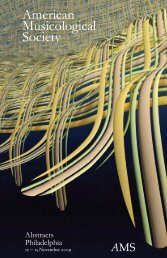Abstracts - American Musicological Society
Abstracts - American Musicological Society
Abstracts - American Musicological Society
You also want an ePaper? Increase the reach of your titles
YUMPU automatically turns print PDFs into web optimized ePapers that Google loves.
26<br />
ErLdaY morning<br />
formed the "prlmeval ce11" of the song's t:1"<br />
^t^it1e<br />
fron a pentatonic scale fragnent that diffuses<br />
--the<br />
traditional goar-oriented process of tonality'^ ylth<br />
the aid of Linear and notiilc analysis one can follow<br />
Mahler' s progress from raw sketch to fair copy<br />
'<br />
observing how-he deploys the basic nusical material in<br />
local an-tl lLarge-scal-e contexts to create "feeling that<br />
rises to the lips but does not pass beyond them," as he<br />
put it. This paper will present sketch transcriptions,<br />
analyses, and taped musical examples focusing on the<br />
development of three crucial passages in the song: 1)<br />
the central modulation in the second s trophe ; 2 ) the<br />
climax; and 3) the recapitulatory final strophe.<br />
ON THE CHRONOLOGY OF<br />
Christopher Lewis,<br />
THE<br />
Universi Ey of Alberta<br />
Attempts to establish a conpositional chronology<br />
for Mahler' s<br />
must depend upon<br />
contradictory secondary sources and an incomplete and<br />
pwzzling set of holograph scores. We may never be<br />
certain which three (or two) songs lrere composed in<br />
1901 and which two (or three) in 1904. The known<br />
cornplete holographs ( in the Pierpont Morgan Library)<br />
comprise piano-vocal "drafts" of the last four songs<br />
and Orchestral Drafts for all five. Two sketches, one<br />
now lost, are also known. Although evidence of the<br />
paper types is inconclusive, the papers of the<br />
piano-voca1 scores do reflect two different<br />
compositional stages: trro scores are Composition<br />
Drafts and two are Fair Copies.<br />
De 1a Grange supposed in 1973 rhat the first three<br />
songs date frorn 1901 and the last two from 1904;<br />
Mitchell has rnore recently suggested that the third and<br />
fourth are from 19O4 and the others frorn 1901. The<br />
piano manuscripts provide evidence that Mahler made the<br />
Orchestral Drafts directly fron these curiously<br />
different sources, and therefore probably never did<br />
make Fair Copies for at least two of the songs. This<br />
in turn gives a rationale for a dating that reverses<br />
the previously presumed chronology of two pairs of<br />
songs. The revised dating then stimulates a<br />
re - examination of the relationship between the<br />
Adagietto of the Fifth Synphony and the<br />
Kindertotenlieder and other Rtickert songs Mahler<br />
conposed in 1901.<br />
THE HIDDEN PROGRAM IN THE<br />
FIFTH SYMPHONY OF GUSTAV MAHLER<br />
James L. Zychowicz, University of Cincinnati<br />
.h" ,'"xn"tT .11:t'"'" f or oecame both<br />
"tl::"lil 'fi;;:";?"n"J increas ingly










